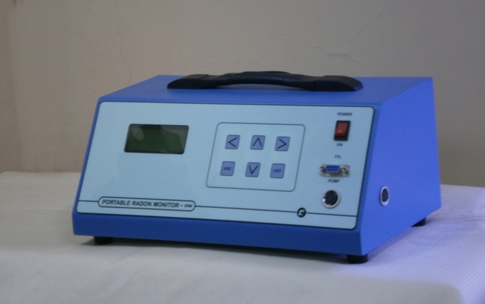

The Smart Radon Monitor (SRM) is a technologically advanced real time, portable, radon monitor, designed for multiple applications in radon studies. The SRM is useful for continuous radon monitoring in air, water and soil. It may be used for measurement of radon emission (Surface/ Mass Exhalation) from various sources such as building materials, soil, rocks, coal, fly-ash, Uranium tailings etc. The monitor also finds application in public domain such as radon survey in houses, caves, seismic sites etc.
The Smart Radon Monitor (SRM) is a technologically advanced real time, portable, radon monitor, designed for multiple applications in radon studies. Radon measurements are based on detection of alpha emitted from radon and its decay products formed in a scintillation cell. An Indigenous smart algorithm has been implemented in the micro-processor, which automatically compensates the background counts due to residual decay products of radon and thus able to measure radon concentrations in a continuous fashion.
The SRM is advantageous for
The SRM is useful for continuous radon monitoring in air, water and soil. It may be used for measurement of radon emission (Surface/ Mass Exhalation) from various sources such as building materials, soil, rocks, coal, fly-ash, Uranium tailings etc. The SRM finds wide applications in nuclear sectors such as network based radon monitoring inside uranium mine, soil gas radon measurement for uranium exploration studies and base line survey for upcoming nuclear facilities. The monitor also finds application in public domain such as radon survey in houses, caves, seismic sites etc. It can be also used for calibration of radon active or passive detector system.
The Smart Radon Monitor (SRM) is a technologically advanced real time, portable, radon monitor, designed for multiple applications in radon studies.
The radon (222Rn) measurements are based on detection of alpha emitted from radon and its decay products formed in a scintillation cell. Radon is sampled into the scintillation cell through a "particulate filter" and thoron (220Rn) barrier. The alpha scintillations from radon and its decay products formed inside the cell are continuously counted by a PMT and the associated counting electronics. An Indigenous smart algorithm implemented in the micro-processor automatically compensates the background counts due to residual decay products of radon and is thus able to report radon activity concentrations in a continuous fashion.
The SRM finds a wide application in nuclear sector, public domain and various R&D organizations. In nuclear sectors, SRM may be used for network based radon monitoring inside uranium mine, soil gas radon measurement for uranium exploration studies and base line survey for upcoming nuclear facilities. In public domain, SRM may be used for radon survey in houses, caves, seismic sites etc. It may be used for radon measurements in water samples. In R&D sector, SRM may be used for calibration of active or passive radon detector systems. It may be used for measurement of radon emission (Surface/ Mass Exhalation) from various sources such as building materials, soil, rocks, coal, fly-ash, Uranium tailings etc and also find application in gas monitoring for earth quake studies.
The alpha scintillation technique deployed in SRM has many advantages over the solid state alpha spectroscopy technique currently in use. The technique is more sensitive for radon than alpha spectroscopy technique. More importantly, the measurements with scintillation detector are unaffected by humidity and trace gas presence in sample gas. Various advantages of SRM are:
Most of the manufacturing & testing equipments are available in local market and local agents are available for some imported components such as Photomultiplier tube, ZnS:Ag scintillator.
A mechanical workshop having lathe, sheet bending machine and an electronic workshop having oscilloscope, high voltage measurement probe are required.
Two trained personnel having Diploma in Mechanical, Electronics Engineering. , One software Engr. With two semi-skilled workers would be adequate for production of SRM.
